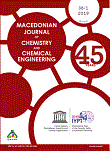Synthesis and characterization of mixed ligand Cu(II) complexes of 2-methoxy-5-sulfamoylbenzoic acid and 2-aminopyridine derivatives
DOI:
https://doi.org/10.20450/mjcce.2019.1698Keywords:
2-Methoxy-5-sulfamoylbenzoic acid, 2-aminopyridine, mixed ligand, Cu(II) complex.Abstract
A novel Cu(II) complex 1 of 2-methoxy-5-sulfamoylbenzoic acid (Hsba) and eight novel mixed-ligand Cu(II) complexes 2–9 have been prepared using Hsba and 2-aminopyridine derivatives [2,3-diaminopyridine (2,3dap), 2,3-diamino-5-bromopyridine (2,3da5Brp), 2,3-diamino-5-chloropyridine (2,3da5Clp), 2-amino-3-benzyloxypyridine (2a3bxp), 2-amino-3-hydroxypyridine (2a3OHp), 2-amino-3-methylpiridine (2a3mp), 2-amino-3-methyl-6-ethylpiridine (2a3m6Etp) and 2-amino-3-nitro-6-methylpiridine (2a3NO26mp)], respectively. The structures of the amorphous metal complexes have been proposed by evaluating the data obtained from elemental analysis, inductively coupled plasma optical emission spectrometry (ICP-OES), Fourier-transform infrared spectroscopy (FTIR), ultraviolet–visible spectroscopy (UV–Vis), magnetic susceptibility and molar conductivity methods.
References
C. T. Supuran, A. Casini, A. Mastrolorenzo, A. Scozzafava, COX-2 Selective inhibitors, carbonic an-hydrase inhibition and anticancer properties of sulfon-amides belonging to this class of pharmacological agents, Mini-Rev. Med. Chem. 4, 625–632 (2004).
DOI: 10.2174/1389557043403792.
A. Scozzafava, T. Owa, A. Mastrolorenzo, C. T. Supuran, Anticancer and antiviral sulfonamides, Curr. Med. Chem. 10, 925–953 (2003).
DOI: 10.2174/0929867033457647.
Z. H. Choan, M. Hassan, M. K. Khan, C. T. Supuran, In-vitro antibacterial, antifungal and cytotoxic proper-ties of sulfonamide-derived Schiff's bases and their metal complexes, J. Enzyme Inhib. Med. Chem. 20, 183–188 (2005).
DOI: https://doi.org/10.1080/14756360500043257.
C. Yenikaya, M. Sarı, M. Bülbül, H. İlkimen, H. Çelik, O. Büyükgüngör, Synthesis, characterization and antiglaucoma activity of a novel proton transfer compound and a mixed-ligand Zn(II) complex, Bioorg. Med. Chem. 18, 930–938 (2010).
DOI: https://doi.org/10.1016/j.bmc.2009.11.031.
G. H. Hamor, B. L. Reavlin, Anticonvulsants III: Al-kyl esters of 4-bromo-2-sulfamoylbenzoic acid and 4-chloro-2-sulfamoylbenzoic acid, J. Pharm. Sci. 56, 134–136 (1967). DOI: https://doi.org/10.1002/jps.2600560127.
G. H. Hamor, N. Farraj, Synthesis and anticonvulsant activity of some alkyl esters of 6-chloro-2-sulf-amoylbenzoic acid, J. Pharm. Sci. 54, 1265–1268 (1965).
DOI: https://doi.org/10.1002/jps.2600540908.
R. Ulus, B. Z. Kurt, I. Gazioğlu, M. Kaya, Microwave assisted synthesis of novel hybrid tacrine-sulfonamide derivatives and investigation of their antioxidant and anticholinesterase activities, Bioorg. Chem. 70, 245–255 (2017).
DOI: https://doi.org/10.1016/j.bioorg.2017.01.005.
R. Kumar, S. Bua, S. Ram, S. D. Prete, C. Capasso, C. T. Supuran, P. K. Sharma, Benzenesulfonamide bear-ing imidazothiadiazole and thiazolotriazole scaffolds as potent tumor associated human carbonic anhydrase IX and XII inhibitors, Bioorg. Med. Chem 25, 1286–1293 (2017).
DOI: https://doi.org/10.1016/j.bmc.2016.12.047.
B. K. London, M. O. F. Claville, S. Babu, F. R. Fronczek, R. M. Uppu, A co-crystal of nona-hydrated disodium(II) with mixed anions from m-chloro¬benzoic acid and furosemide, Acta Cryst. E71, 1266–1269 (2015). DOI: 10.1107/S2056989015017430.
T. Hökelek, V. Yavuz, H. Dal, H. Necefoğlu, Crystal structure and Hirshfeld surface analysis of aqua-bis(nicotinamide-κN)bis(4-sulfamoylbenzoato-κO1)cop¬per(II), Acta Cryst. E74, 45–50 (2018).
DOI: https://doi.org/10.1107/S2056989017017765.
X. H. Li, Bis(μ-4-sulfamoylbenzoato)bis[chloro(di-2-pyridylamine)copper(II)] dihydrate, Acta. Cryst. E61, m2623–m2625 (2005).
DOI: https://doi.org/10.1107/S1600536805036858.
H. Fuhrmann, S. Brenner, P. Arndt, R. Kempe, Octahedral group 4 metal complexes that contain amine, amido, and aminopyridinato ligands: synthesis, structure, and application in α-olefin oligo- and polymerization, Inorg. Chem. 35, 6742-6745 (1996). DOI: 10.1021/ic960182r.
C. Yenikaya, N. Büyükkıdan, M Sarı, R. Keşli, H. İlkimen, M. Bülbül, O. Büyükgüngör, Synthesis, characterization, and biological evaluation of Cu(II) complexes with the proton transfer salt of 2,6-pyridinedicarboxylic acid and 2-amino-4-methylpyridine, J. Coord. Chem. 64, 3353–3365 (2011).
DOI: https://doi.org/10.1080/00958972.2011.620608.
S. Mistri, E. Zangrando, S. C. Manna, Cu(II) com-plexes of pyridine-2,6-dicarboxylate and N-donor neu-tral ligands: Synthesis, crystal structure, thermal be-havior, DFT calculation and effect of aromatic com-pounds on their fluorescence, Inorg. Chim. Acta 405, 331–338 (2013). DOI: https://doi.org/10.1016/j.ica.2013.06.019.
R. K. Poddar, U. Agarwala, Reactions of Ru(PPh3)2Cl2 and [Ru(AsPh3)2Cl2]2 with various donor molecules, J. Inorg. Nucl. Chem. 35, 3769–3779 (1973).
DOI: https://doi.org/10.1016/0022-1902(73)80068-5.
A. G. Raso, J. J. Fiol, A. L. Zafra, A. Cabrero, I. Mata, E. Molins, Crystal structures of the N-salicylidene–L-serinatoaquacopper(II) monohydrate and its ternary derivative with 2-aminopyridine, Polyhedron 18, 871–878 (1999).
DOI: https://doi.org/10.1016/S0277-5387(98)00373-8.
C. Yenikaya, M. Poyraz, M. Sarı, F. Demirci, H. İlkimen, O. Büyükgüngör, Synthesis, characterization and biological evaluation of a novel Cu(II) complex with the mixed ligands 2,6-pyridinedicarboxylic acid and 2-aminopyridine, Polyhedron 28, 3526–3532 (2009).
DOI: https://doi.org/10.1016/j.poly.2009.05.079.
K. Nakamoto, Infrared and raman spectra of inorganic and coordination compounds. 5th ed., Wiley-Interscience, NewYork 1997, p. 232.
W. J. Geary, The use of conductivity measurements in organic solvents for the characterisation of coordina-tion compounds, Coord. Chem. Rev. 7, 81–122 (1971).

